Ankle Sprains
 Read What Mr Gordon’s Patients Are Saying
Read What Mr Gordon’s Patients Are Saying
What is it?
A sprain is a tear or disruption of the soft tissue structures in the body. This follows an injury and causes pain, swelling and disability. Ankle sprains usually involve the lateral ligament complex (outside of the ankle) and commonly involve 2 ligaments (anterior talofibular ligament and calcaneo-fibula ligament).
What causes it?
The classic injury is an inversion type, where the sole of the foot turns in and the outside ankle ligaments are stretched and injured. This may be sustained during sport or wearing high heels after a few too many drinks! However, any fall or trip on uneven ground may cause a sprain.
What are the symptoms?
Immediate pain and swelling around the ankle (usually the outside), the inability to bear weight on the foot. Bruising appears hours or days later and can be around the toes, mid foot, heel or calf. Symptoms can last a week to more than a month, depending on the severity of the sprain.
How is it diagnosed?
Mr Gordon will take a thorough history and examination and perform radiographs (x-rays) and this is normally sufficient to make a diagnosis. It is important to rule out a fracture or other ligament or tendon injury, which is why a review by an experienced foot and ankle specialist is often necessary. Sometimes the diagnosis may not be clear and a CT or MRI scan may be required.
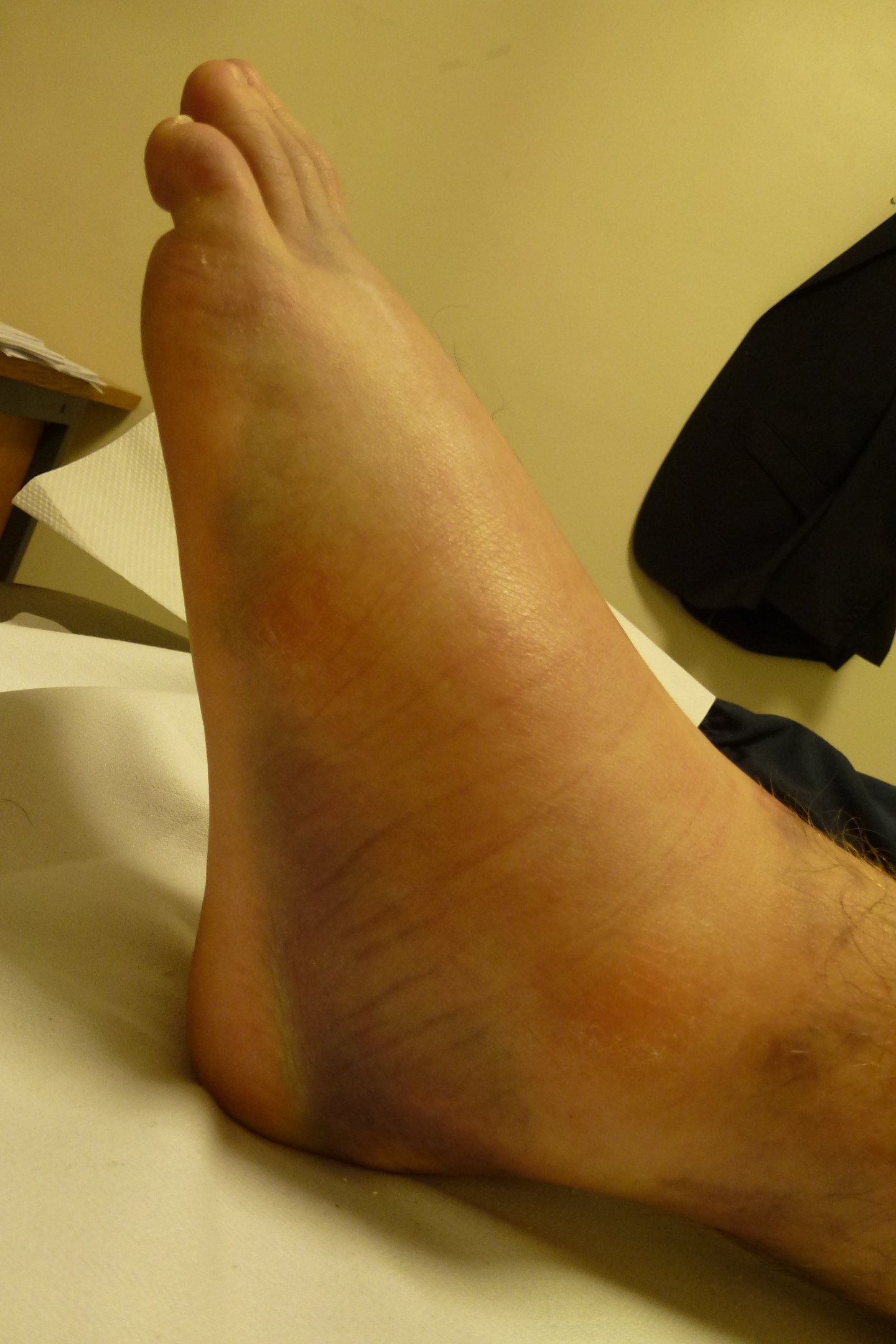 A grade 3 Ankle Sprain showing swelling and bruising
A grade 3 Ankle Sprain showing swelling and bruising
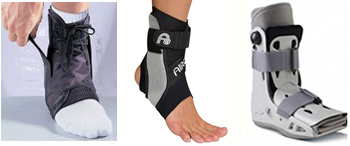
Ankle braces with rigid side supports. Lace up types: LP Elite by McDavid (left) or Ankle Brace by Mueller.
Velcro type: A60 by Aircast
Rigid walking boot (right) AirSelect Short Walking Boot by Aircast
How is it treated?
This will depend on the severity of the sprain, of which there are 3 grades.
Grade 1: Minor bruising and swelling – Weight bear as tolerated, no ankle support needed
Grade 2: Moderate bruising and swelling – Weight bear as tolerated but may need an ankle brace (pictured) for about 4 weeks or until rehabilitation goals met
Grade 3: Severe bruising and swelling and instability – Weight bear as tolerated in a rigid walking boot (pictured) for 4 weeks, to be worn 24 hours a day and boot kept on for sleep. Then use an ankle brace (only needed when weight bearing), until rehabilitation goals met (approximately 1 month)
In addition to these measures, for all ankle sprains, the following regime should be adhered to:
PRICE: Protection, Rest, Ice, Compression, Elevation
Protection: An ankle brace or rigid walking boot may be needed for comfort, but is not always necessary
Rest: Keeping the weight off the leg using crutches may make things more comfortable, but not always necessary
Ice: or frozen vegetables for 10 minutes with a 10 minutes break then for 10 minutes again, 3 times/day, until swelling has subsided (days to weeks)
Compression: This helps reduce swelling but is not essential
Elevation: Perhaps the most important factor, as gravity will cause the fluid to drain to the lowest part of the body. Keep the ankle elevated at the level of the chest for 23 hours/day during the first 2 days and continue this regime whilst significant swelling is present. Swelling will be the worst at the end of the day and best first thing in the morning.
Anti-inflammatory medication (ibuprofen, naproxen, diclofenac) may be taken, in addition to analgesics (pain killers eg paracetamol, coedine)
What exercises can I do to speed up my recovery?
Scientific evidence has shown that early mobilisation of the ankle following a grade 1 or 2 sprain can speed up recovery and ankle function and earlier return to sport, compared with immobilisation. Therefore, it is important to start exercises once comfortable to do so. There is also evidence that if these exercises are supervised by a physiotherapist, then faster recovery may occur.
ReApp Ankle – The Android App
This App is designed as a rehabilitation tool that clinicians can recommend to their patients once they have seen the patient. The app provides detailed information on rehabilitation exercises that can help improve recovery after an ankle sprain. The clinician can direct the patient on use of the App. Each exercise should be introduced progressively throughout recovery. The exercises aim to improve ankle muscle strength, range of movement, and balance. This App is not recommended as a self-management tool without expert clinical advice.
How long before I can get back to sport/activities?
This will depend on the grade of the injury. Generally, after the first 2 weeks, things will feel considerably better and swimming or low impact activities may be attempted if allowed depending on the grade of sprain. It may be 1 month or more before full activities can be resumed.
What if I have persistent symptoms?
Between 5-34% of people at 1 year following an ankle sprain, continue to have pain. The risk of a re-sprain is 3-34% and recurrent instability can occur in up to 33%. If you have persistent symptoms you should make an appointment with Mr Gordon further evaluation to find the cause of your symptoms. Ankle instability (recurrent sprains) may occur.
References
van Rijn et al. Effectiveness of additional supervised exercises compared with conventional treatment alone in patients with acute lateral ankle sprains: systematic review. BMJ 2010
van Rijn et al. What Is the Clinical Course of Acute Ankle Sprains? A Systematic Literature Review. AJM 2008
Bleakley et al. Effect of accelerated rehabilitation on function after ankle sprain: randomised controlled trial. BMJ 2010
Rehabilitation Exercises
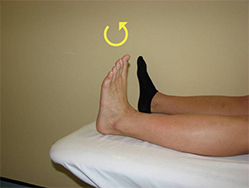
1. Active Circumduction
Rotate the foot so the toes ‘draw’ a circle in the air, clockwise and anti-clockwise
20 circles over 60 seconds
2. Active Ankle Dorsiflexion (foot up) and Plantarflexion (foot down)

Move foot up and down (1 repetition) Repeat 20 times over 60 seconds
3. Static Strengthening of:
3a: Invertor muscles
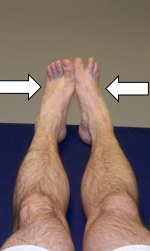
Push both feet together and hold for 10 seconds
Repeat 5 times
3b: Evertor muscles
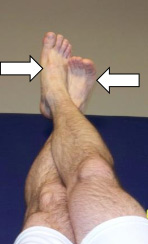
Cross legs over
Push both feet together and hold for 10 seconds
Repeat 5 times
Swap over feet
3c: Dorsiflexion and Plantarflexion muscles
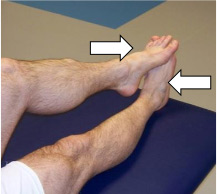
Place once foot over the other
Push up with lower foot, resisted by upper foot
Hold for 10 seconds
Repeat 5 times
Swap over feet and repeat
4. Triple Flexion/Extension (hip, knee, ankle)
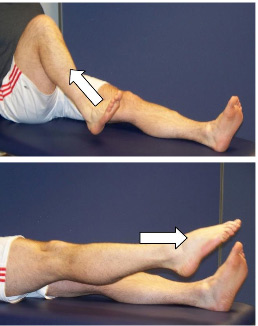
Bring knee toward chest bringing foot and ankle up
Straighten leg, pointing toes
Repeat 30 times
5. Triceps Surae Stretch
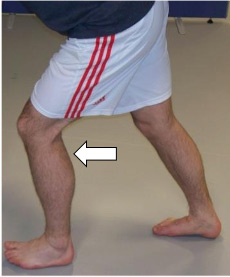
Place feet apart and put hands on a wall
Have injured leg toward the rear
Keep feet in place on ground
Lean forward, keeping the heel of the rear (injured) foot on the ground
Hold for 20 seconds
Repeat 3 times
Swap feet
 Call for an Appointment
Call for an Appointment 





